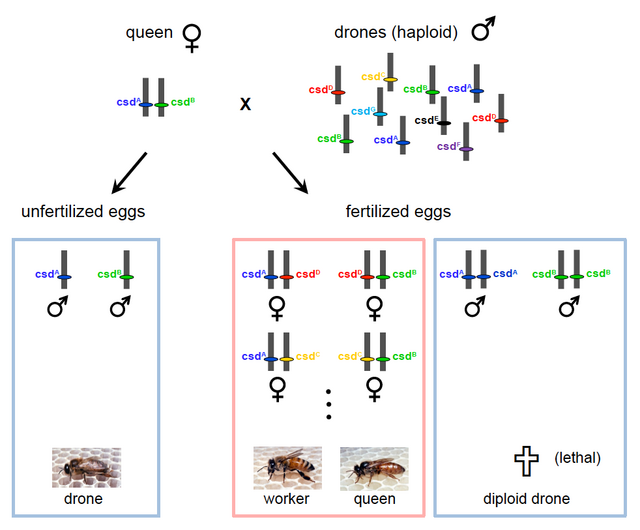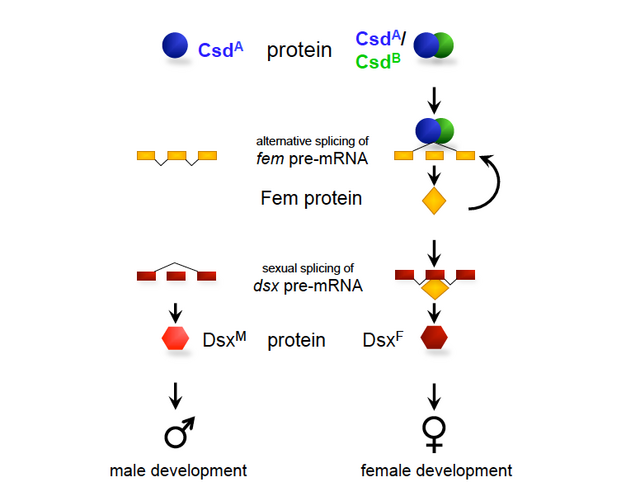Haplodiploidy and Complementary Sex Determination
The first genetic mechanism for sex determination in general was proposed in the mid-1800s by the Silesian Priest Johann Dzierzon1, who was trying to understand how males and females were produced in honeybee colonies. He knew that the differences between queen and worker bees-both female-emerged from the different quality and quantity of food provided to each type. But what about the males? Dzierzon postulated that male bees derive from unfertilized eggs, while females come from fertilized eggs. Male bees possess one set of chromosomes, while the females have two sets, a phenomenon known as haplodiploidy that was later confirmed with the development of high-quality microscopes. Today, we know that 20% of animal species employ haplodiploidy to determine sex, including 115,000 described species of Hymnopteran insects, of which wasps, bees, and ants are the major groups. However, how this system of haplodiploid sex determination is regulated and how it evolved at a molecular level has remained one of the most important remaining questions in developmental biology.
Our research group identified a single gene, the complementary sex determiner (csd), as the primary genetic signal determining femaleness and maleness under haplodiploidy 2. The gene encodes an Arginine-Serine-rich (SR) type protein and segregates into multiple forms (alleles) in honeybee populations, displaying polymorphism on average of ~5% 3-5. Csd proteins that derive from different alleles activate the female pathway, while proteins that derive from single alleles (that is, from a single, or haploid chromosome) ensure maleness (Fig. 1). Meanwhile, when Csd proteins in fertilized and diploid eggs come from the same alleles, which determine the sex of larvae as male, lethality is induced as follows. Hatching diploid male larvae with a homozygous csd genotype (Fig. 1) are recognized and eaten by the worker bees, which provides a text book example of a single gene under strong (balancing) selection 6.

The complementary mechanism of sex determination 7 enables females to control the sex (female-to-male) ratio, ensuring outbreeding and achieving a close mother-daughter genetic relationship, features which have facilitated the evolutionary transition to sociality in bees, ants, and wasps 8.
Our studies have further shown that the csd gene evolved through gene duplication and positive selection from a gene copy of the sex determination gene feminizer (fem) (Fig. 2) 9. We showed that at least five amino-acid differences in the RS (Arginine-Serine-rich) domain and length differences in the arginine-tyrosine-enriched, variable region of the Csd proteins are essential for determining femaleness 5. We found that new alleles can gradually and adaptively evolve a female-switch function through incomplete penetrance (i.e., evolutionary intermediates induce femaleness only in a portion of offspring) 5. We showed that the csd signal is transmitted in females through the sexual splice regulation of the fem gene and maintained via a positive regulatory feedback loop (Fig. 2). Fem proteins in females sexually regulate downstream genes, thereby executing female differentiation 10. Maleness is determined by default when the above processes do not occur.

Several fundamental aspects remain unknown. In our future research, investigating these aspects will guide us to understand novel control mechanisms and their evolutionary origins.
- How do amino-acid differences in Csd proteins regulate the genetic switch of either female- or maleness?
- Through what molecular mechanisms is the transmission of the female signal achieved?
- How does the general development process integrate sexual identity?
The latter question is particularly interesting because the female signal must control the development of two different female castes, the worker and the queen, a process that evolved within the last 60 million years.
1 Dzierzon, J. Gutachten über die von Herrn Direktor Stöhr im ersten und zweiten Kapitel des General-Gutachtens aufgestellten Fragen. Eichstädter Bienenzeitung 1, 109-113, 119-121 (1845).
2 Beye, M., Hasselmann, M., Fondrk, M. K., Page, R. E. & Omholt, S. W. The gene csd is the primary signal for sexual development in the honeybee and encodes an SR-type protein. Cell 114, 419-429 (2003).
3 Hasselmann, M. et al. Evidence for convergent nucleotide evolution and high allelic turnover rates at the complementary sex determiner gene of Western and Asian honeybees. Mol.Biol.Evol. 25, 696-708 (2008).
4 Hasselmann, M. & Beye, M. Signatures of selection among sex-determining alleles of the honeybee. Proc Natl Acad Sci U S A 101, 4888-4893 (2004).
5 Beye, M. et al. Gradual molecular evolution of a sex determination switch through incomplete penetrance of femaleness. Curr Biol 23, 2559-2564, doi:10.1016/j.cub.2013.10.070 (2013).
6 Charlesworth, D. Evolutionary genetics: changed sex determination in honeybees. Curr.Biol. 18, R610-R612 (2008).
7 Whiting, P. W. Multiple alleles in complementary sex determination of Habrobracon. Genetics 28, 365-382 (1943).
8 Bourke, A. F. Hamilton's rule and the causes of social evolution. Philos Trans R Soc Lond B Biol Sci 369, 20130362, doi:10.1098/rstb.2013.0362 (2014).
9 Hasselmann, M. et al. Evidence for the evolutionary nascence of a novel sex determination pathway in honeybees. Nature 454, 519-522 (2008).
10 Gempe, T. et al. Sex determination in honeybees: two separate mechanisms induce and maintain the female pathway. PLoS.Biol. 7, e1000222 (2009).

